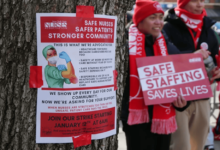The value of student nurses versus assistants was debated in 1924

In early 1924, the 2 February issue of Nursing Times was concerned about training in small hospitals. The lead story warned that the proper training of probationers – an old name for student nurses – in “small infirmaries is a great and increasing difficulty”.
It highlighted, as an example, the Guardians of the Poor of the Dartford Union, a group responsible for administering poor relief in that part of Kent, which was considering closing its training school for nurses. According to Nursing Times, in place of the probationers, the guardians were thinking of reverting to employing assistant nurses to look after patients.
The editor of Nursing Times, Swanhilde Bulan, was not impressed at this idea, railing against the kind of view that was still prevalent decades later when nursing was becoming a graduate-only entry profession in 2009 and, sadly, is still around today in some quarters.
“Apparently they are… under the delusion that a nurse without theoretical knowledge, who has not attended lectures, is sure to be patient and kind; and therefore that assistant nurses would do the work better than probationers,” she said. “A very short experience of hospital life would convince any impartial person that kindness, sympathy and the faculty of making patients happy are qualities that theoretical study can neither give nor take away,” she noted.
Ms Bulan also highlighted workforce supply and demand as another challenge to the plan. She said: “One great drawback to the employment of assistant nurses is that, these days, a good type of woman will not take such a post. Capable, efficient girls become fully-trained nurses… A woman with any capability or force of character soon gets tired of work which gives no prospect.”
According to Ms Bulan – and with echoes of later NHS policy – it would be better to close small infirmaries and “concentrate the patients in larger hospitals in convenient centres”. She said the advantages for nursing would be “very great” as probationers could then have a “really good all-round training”.
Giving a damning verdict on smaller hospitals of the era, she added: “In very small infirmaries, the work is practically all chronic – there are no operations and very little medical work; the treatment, even of chronic cases, is not modern and amounts to little more than making them as comfortable as possible until they die.”
Another article, The Children’s Nurse, described the role and supposed attributes of those considering that career. Written by a Dr Richard Smith, the article was thorough, but could be said to stray into being patronising.
“The most important thing for any nurse to have, who is working with children, is knowledge of what the normal child does and what the normal child requires,” he said, having seemingly met a lot of ‘normal’ children. Leaving no room for doubt, he added: “Any nurse who is working with infants and children must love children… to be successful.”
The next article, on the “unique” London Fever Hospital (pictured), described the establishment, estate and type of work done there. “Cases include any infectious fever, as well as influenza, pneumonia, rheumatic fever, encephalitis lethargica, and cerebro-spinal fever, but smallpox is not taken,” said the article. “The general wards are very comfortable, painted in a soft shade of green,” it added. The hospital, which had 150 beds in 1924, closed in 1975 and was later converted into flats.
Further on, a report described an event under the intriguing headline: Archbishop and Nurses. It covered a prizegiving for nurses at Leeds General Infirmary with the Archbishop of York, Cosmo Gordon Lang. In his speech, he recalled first visiting an advanced dressing station and field hospital during the First World War, where he witnessed nurses’ care and skill, and said thousands of troops would have experienced the same. Clearly moved, he said: “For that reason, I think the nursing profession has gained a position such as it never had before in history.”
Elsewhere, the advertising section recommended Subitine, a waterless antiseptic wound dressing, for removing “all risk of extension of sepsis, oedema of tissues and delayed healing”, while Idozan, a colloidal iron concentrate, was commended as a “valuable asset to the administration” of cod liver oil, “rendering the latter almost unobjectionable”. Readers were also advised to have a “beauty bath” with Icilma Cream daily before going out. “Keep the beauty of your girlhood days by using non-greasy Icilma Cream, the world’s finest toilet cream, regularly,” stated the advert.
Nursing Times Archive
With Nursing Times’ online archive of its print issues, subscribers can dip into the history of nursing at the touch of a button and discover how it has changed over the decades. Each issue’s stories, features and even advertisements give a fascinating insight into the profession and much more. Representing over 100 years of nursing history, the Nursing Times Archive starts with the very first issue of the magazine, which was published on 6 May 1905. This great resource can be accessed directly from our website.
To start exploring, visit: nursingtimes.net/digital-archive







